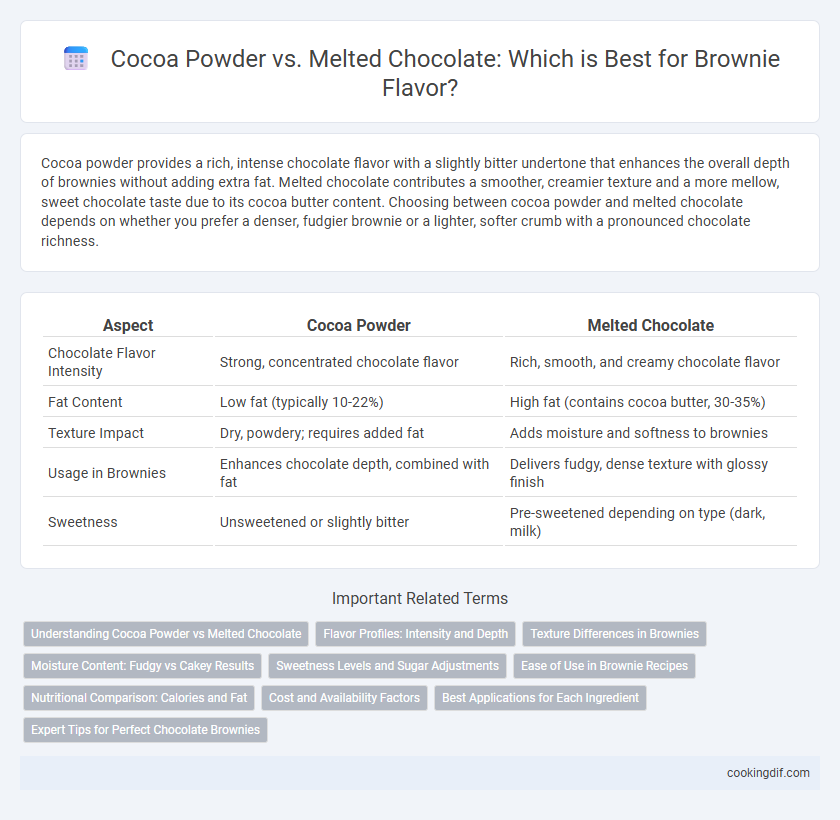Cocoa powder provides a rich, intense chocolate flavor with a slightly bitter undertone that enhances the overall depth of brownies without adding extra fat. Melted chocolate contributes a smoother, creamier texture and a more mellow, sweet chocolate taste due to its cocoa butter content. Choosing between cocoa powder and melted chocolate depends on whether you prefer a denser, fudgier brownie or a lighter, softer crumb with a pronounced chocolate richness.
Table of Comparison
| Aspect | Cocoa Powder | Melted Chocolate |
|---|---|---|
| Chocolate Flavor Intensity | Strong, concentrated chocolate flavor | Rich, smooth, and creamy chocolate flavor |
| Fat Content | Low fat (typically 10-22%) | High fat (contains cocoa butter, 30-35%) |
| Texture Impact | Dry, powdery; requires added fat | Adds moisture and softness to brownies |
| Usage in Brownies | Enhances chocolate depth, combined with fat | Delivers fudgy, dense texture with glossy finish |
| Sweetness | Unsweetened or slightly bitter | Pre-sweetened depending on type (dark, milk) |
Understanding Cocoa Powder vs Melted Chocolate
Cocoa powder delivers a rich, concentrated chocolate flavor with less fat compared to melted chocolate, making it ideal for a dense, fudgy brownie texture. Melted chocolate contains cocoa butter, which adds moisture and a creamier mouthfeel, influencing both flavor depth and brownie consistency. Choosing between cocoa powder and melted chocolate significantly affects the balance of taste, texture, and fat content in brownie recipes.
Flavor Profiles: Intensity and Depth
Cocoa powder delivers a rich, intense chocolate flavor with a slightly bitter and earthy undertone, enhancing the depth of brownies without adding extra fat. Melted chocolate provides a smoother, creamier taste, contributing sweetness and a fuller, more luxurious texture due to its cocoa butter content. Combining both ingredients balances the intensity and depth, creating a complex chocolate profile preferred in gourmet brownie recipes.
Texture Differences in Brownies
Cocoa powder creates a denser, fudgier texture in brownies due to its dry, unsweetened nature that absorbs moisture, while melted chocolate adds richness and a more luxurious, moist crumb because of its fat content. Using cocoa powder results in a lighter, more cake-like structure with a slightly chalky mouthfeel, whereas melted chocolate yields a denser, gooier texture with a smoother finish. The choice between cocoa powder and melted chocolate significantly impacts the brownie's chewiness and overall mouthfeel, with cocoa emphasizing depth of flavor and melted chocolate emphasizing creamy richness.
Moisture Content: Fudgy vs Cakey Results
Cocoa powder, with its low moisture content, yields a drier, cakey brownie texture by absorbing more liquid during baking. Melted chocolate contains cocoa butter, which adds fat and moisture, resulting in a fudgier, richer brownie consistency. Choosing between cocoa powder and melted chocolate significantly impacts the moisture balance and final texture of the brownie.
Sweetness Levels and Sugar Adjustments
Cocoa powder provides a more intense chocolate flavor with less sweetness, requiring additional sugar to balance the taste in brownies. Melted chocolate contains natural sugars and fats, resulting in a sweeter and richer profile that often reduces the need for extra sugar. Adjusting sugar levels in recipes depends on the choice between cocoa powder's concentrated bitterness and the inherent sweetness of melted chocolate.
Ease of Use in Brownie Recipes
Cocoa powder offers greater ease of use in brownie recipes due to its quick mixing and incorporation without melting or tempering. Melted chocolate requires careful handling to avoid overheating and seizing, making it less convenient for fast preparation. For bakers seeking simplicity and consistent texture, cocoa powder provides a more user-friendly option.
Nutritional Comparison: Calories and Fat
Cocoa powder contains fewer calories and significantly less fat compared to melted chocolate, making it a lighter option for adding intense chocolate flavor to brownies. While a tablespoon of unsweetened cocoa powder typically has around 12 calories and less than 1 gram of fat, the same amount of melted chocolate can contain nearly 70 calories and up to 5 grams of fat. Choosing cocoa powder over melted chocolate can reduce overall calorie and fat content without compromising the rich chocolate taste in brownies.
Cost and Availability Factors
Cocoa powder generally offers a more cost-effective option for achieving a rich chocolate flavor in brownies, with widespread availability in most grocery stores. Melted chocolate tends to be more expensive due to its higher cocoa butter content and is less consistently stocked, especially specialty varieties like couverture. Choosing cocoa powder can reduce ingredients cost and simplify sourcing, making it a practical choice for both home bakers and commercial production.
Best Applications for Each Ingredient
Cocoa powder provides a rich, concentrated chocolate flavor with a dry texture ideal for light, fudgy brownies that benefit from a deep chocolate essence without added fat. Melted chocolate offers a smoother, creamier texture and enhances moisture, making it better suited for dense, gooey brownies with intense chocolate richness. For recipes requiring a delicate structure and pronounced cocoa notes, cocoa powder is preferred, while melted chocolate excels in tender, fudgy brownie variations needing luxurious mouthfeel.
Expert Tips for Perfect Chocolate Brownies
For perfect chocolate brownies, use high-quality cocoa powder to achieve a deep, intense chocolate flavor with a lighter texture, while melted chocolate provides richness and a fudgy consistency. Experts recommend combining both ingredients to balance the chocolate complexity and moisture, enhancing overall taste and structure. Adjust the ratio based on desired brownie density, with more cocoa powder for cakier results and more melted chocolate for gooier brownies.
Cocoa powder vs melted chocolate for main chocolate flavor Infographic

 cookingdif.com
cookingdif.com